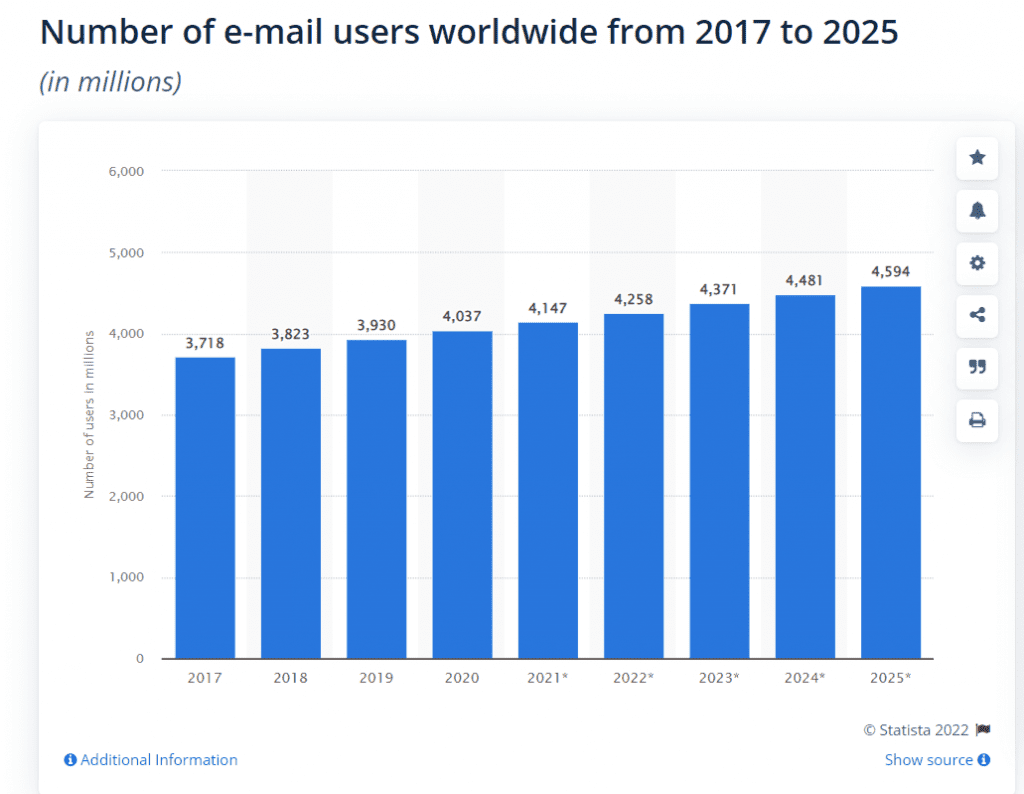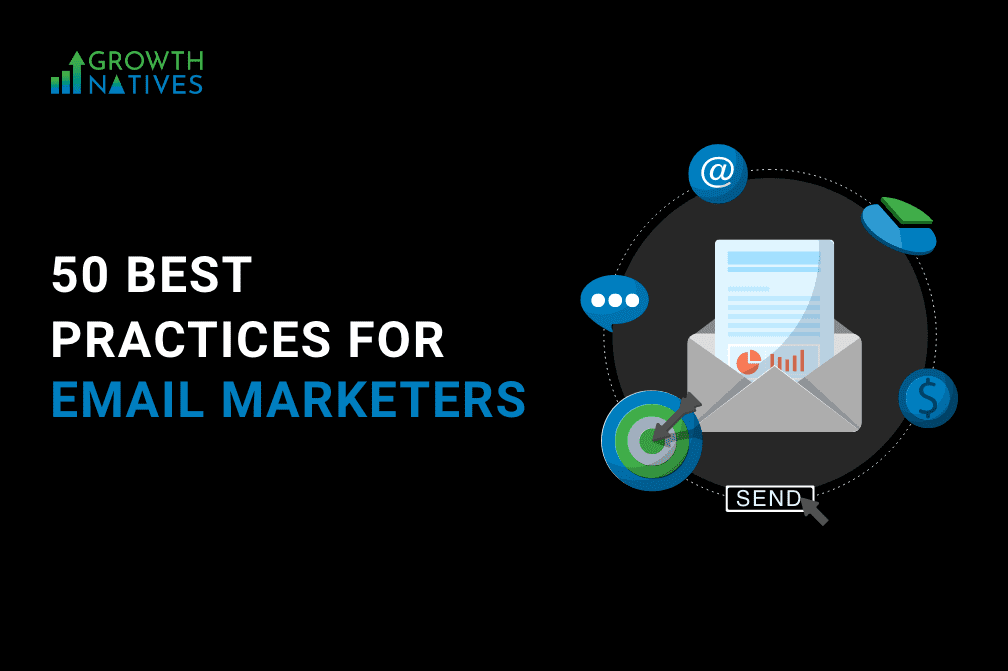
Best Practices to Boost Your B2B Email Open Rates
By Sakshi Arora
Jan 17, 20227 min read
Email marketing is one of the most reliable and popular engagement channels. The number of global email users amounted to four billion in 2020, and the number is expected to grow to 4.6 billion in 2025.

Even though an average person receives around 120 emails daily, hardly anyone opens them all. It means that email marketing is already a saturated space, and with increasing competition, the email open rate remains a highly challenging aspect for marketers.
Moving ahead, let’s discuss why email open rate is important, why it usually falls, and how you can improve it.
Top 5 Reasons Your Average B2B Email Open Rate Is Important
Now, we know why the B2B email open rate is a big challenge for marketers. Let’s find out the top five reasons that make it so essential for every marketing campaign:
- Pivotal to measure the success of your marketing campaign: Email open rate governs the success of your email campaigns. If the email open rate is low, the chances of getting new business from email marketing are equal to zero.
- Allows you to measure the effectiveness of your content and subject lines: If you have an excellent open rate, it means your subject lines and content resonate well with your audience. Otherwise, you may need to change your message or target a different audience.
- Helps you understand customer perception: Customer perception depends upon how your customers view your emails. Are they viewed as useless spam or exciting sources of information? Your email open rate will tell you that.
- Determines the quality of the mailing list: If you are constantly getting low open rates, it is time to evaluate your mailing list. Make sure you are sending relevant personalized information to the right people.
- Helps you segment your audience: Using subscriber location, activities, and other factors, you can segment your audience and improve the success rate of your marketing campaign.
Now that you know why email open rate is essential to the success of your B2B marketing campaign, it’s time you also understood how you can measure it accurately.
How to Measure Your B2B Email Open Rate
There are two main methods of measuring your B2B email open rate:
1st Method
In this method, you need to calculate the following two variables first:
- Number of total recipients
- Number of unique opens
After obtaining the data, you need to divide the number of unique opens by the number of recipients and multiply the obtained number by 100.
Open rate = (Number of unique opens)/(number of total recipients) x 100
Note: If a recipient opens the same email more than once, it is still considered one unique open.
2nd Method
This method is more sophisticated as it also includes the email bounce rate.
To use this method, you need three variables:
- Number of recipients
- Number of unique opens
- Number of bounced emails
Here is the formula to use this method:
Open rate = [(Number of unique opens) / (number of recipients - number of bounced emails)] x 100
For multiple campaigns, you can calculate the average open rate with this formula:
(Campaign A + Campaign B + Campaign C) / Number of campaigns = Average open rate
After determining how to calculate your email open rate, the next step is to understand why your email open rates are falling.
Why Your Email Open Rates Are Falling
Falling email open rates can happen due to several factors. The issue could be fixed in a matter of minutes, or require a bit more digging. Whether it’s a small HTML error or a problem with your marketing strategy, it’s essential to fix it as soon as you can.
Before investigating the issue, make sure it is not a deliverability problem. Check if your emails are reaching the inbox of your customers. If it’s a deliverability issue, it means there’s no issue with the content or subject line of your message.
Otherwise, examine your messaging strategy and check for any changes in the message design, frequency, and type of your content.
Variations in the open rates indicate that there is some change in the opinion of your subscribers and it’s time to discover what can trigger a surge of interest when they see your business’s name.
Tips To Improve Your Average Email Open Rate
To improve your average email open rate, you will have to work on a number of important factors:
- Induce personalization: Personalizing marketing emails go beyond using creative headings; it also involves curating customer-centric content and choosing the optimum time to deliver your message.
- Watch out for spam filters: If your email is marked as spam, there are hardly any chances it will land up in your subscribers' inbox. Keywords like “free”, “incredible deal”, “bonus”, and “click here” have high chances of marking your email as spam.
- Use subject lines that generate interest: If your subject line intrigues your subscriber, it will prompt them to read more. You can create a personalized subject line by including your subscriber's name/ title, or you can add an exciting keyword in the subject line to gain your subscriber’s interest.
- Use a sense of humor: An email in a funny tone can lighten up your reader’s mood. It serves as a bridge to form a relationship with your subscribers. Emails that don’t sound too impersonal and professional can elevate your open rate.
- Test several configurations: Using elements of personalization and intriguing subject lines can be time-intensive, and you may not see immediate results. It is important to try and experiment with different elements to get maximum response from your subscribers.
Best Practices to Increase Email Open Rates
Improving your average email open rate can be a tricky affair if you are not sure about your target audience's interests or don’t know about your brand as yet. Therefore, it’s important to learn, evolve, and implement new strategies to maximize results.
Here are some best practices you can use to optimize your email open rates:
1. Plan your objectives
Before creating an email marketing campaign, make sure to develop the goals you want to achieve through the campaign. It includes understanding why you are using email marketing, what information you want to share with your subscribers, and whether you want to generate leads or solve a problem? Answering all these questions comes under the objectives of your email marketing campaign.
2. Identify and track KPIs
Identify all key performance indicators you want to measure, including email open rate, click-through rate, and conversion rate. The email open rate is limited to telling us whether the subscriber has opened the email or not. The click-through rate suggests how customers are responding to your campaign. The conversion rate tells us about the recipients that have followed through on a call to action.
3. Use analytics
Analytics is an effective way of determining the success of an email marketing campaign. With marketing automation software, you can get accurate metrics on each aspect of your campaign, allowing you to make real-time changes and optimize your campaign performance.
4. Establish the proper sequence
Establishing the appropriate sequence and order of your email marketing campaign can be the difference in its success or failure. Start by mapping out your customer’s journey and ensure your message resonates with their state of mind. Another important aspect is to sign for the email lists of your rivals to get a good idea of their content type, frequency, and other factors.
Wrapping Up
Improving email open rates can be as simple as a tweak or a comprehensive change in your marketing strategy. Investigating KPIs, using personalization, and testing different strategies can be the key to witnessing a high email open rate.
To know more about B2B email marketing and methods to improve email open rate, connect with our team of experts; write to us at info@growthnatives.com.




